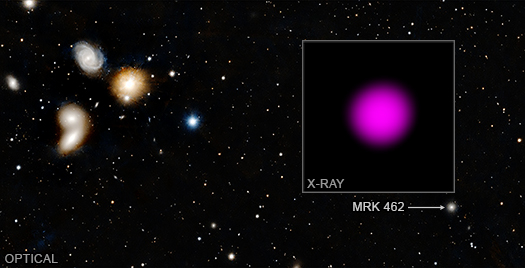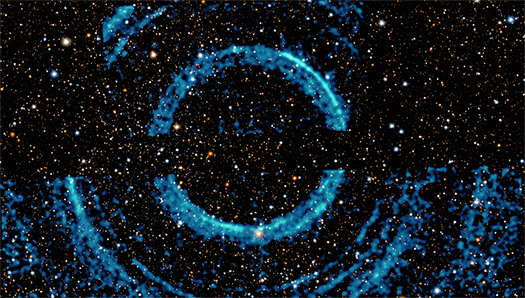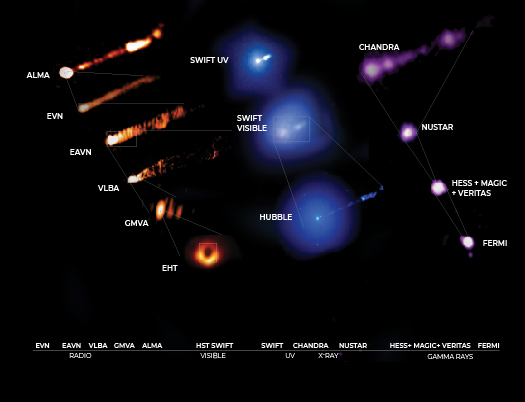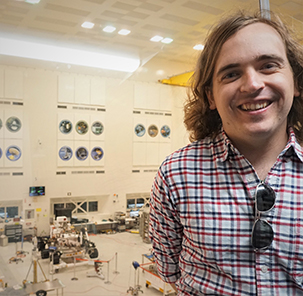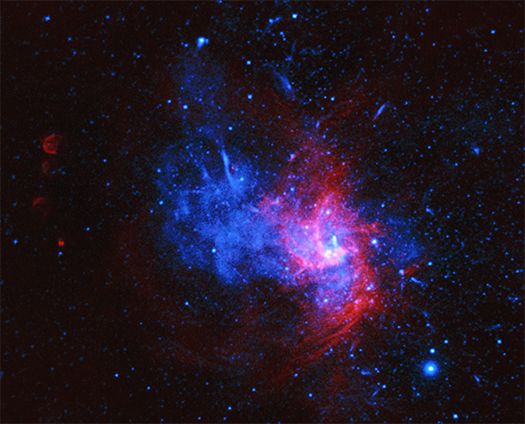Black Holes
An Expanse of Light
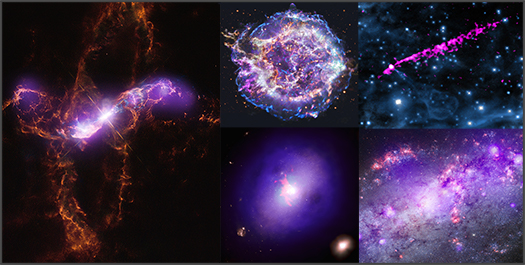
An Expanse of Light
Credit: X-ray: NASA/CXC/SAO; Optical: NASA/STScI, Palomar Observatory, DSS;
Radio: NSF/NRAO/VLA; H-Alpha: LCO/IMACS/MMTF
The recent launches of the James Webb Space Telescope (Webb) and the Imaging X-ray Polarimetry Explorer (IXPE) by NASA and its international partners are excellent reminders that the universe emits light or energy in many different forms. To fully investigate cosmic objects and phenomena, scientists need telescopes that can detect light across what is known as the electromagnetic spectrum.
This gallery provides examples of the ways that different types of light from telescopes on the ground and in space can be combined. The common thread in each of these selections is data from NASA's Chandra X-ray Observatory, illustrating how X-rays — which are emitted by very hot and energetic processes — are found throughout the Universe.
"Mini" Monster Black Hole Could Hold Clues to Giant's Growth
The graphic shows X-rays that NASA's Chandra X-ray Observatory detected from the dwarf galaxy Mrk 462. This X-ray emission (inset) is important because it reveals the presence of a growing supermassive black hole within this relatively small galaxy, as described in our latest press release. The mass contained in this black hole — about 200,000 times the mass of the Sun — provides information to astronomers about how some of the earliest black holes in the Universe may have formed and grown billions of years ago.
The background panel is an optical image from the Pan-STARRS telescope in Hawaii. There are several galaxies that are part of the HCG068 galaxy group on the left-hand side of the image. The galaxy that is emitting copious amounts of X-rays, however, is the much smaller galaxy located to the lower right of the image (marked by the arrow). Mrk 462 is a dwarf galaxy because it contains only a few hundred million stars, which means it holds about a hundred times fewer stars than a galaxy like the Milky Way. Black holes are notoriously hard to find in dwarf galaxies because they are usually too small and dim for optical light telescopes to track the rapid motions of stars in the centers.
"X-ray Magnifying Glass" Enhances View of Distant Black Holes
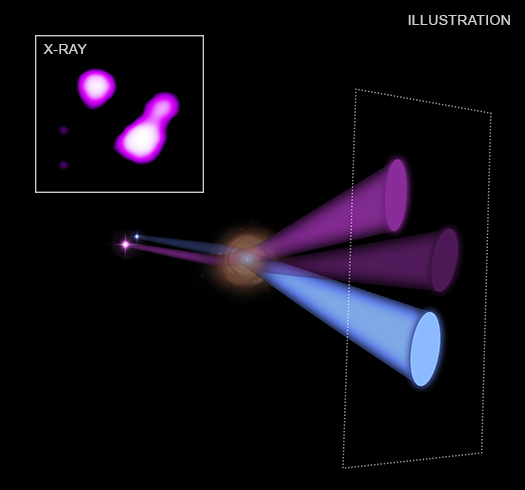
Gravitationally-Lensed System MG B2016+112
Credit: Illustration: NASA/CXC/M. Weiss; X-ray (inset): NASA/CXC/SAO/D. Schwartz et al.
A new technique using NASA's Chandra X-ray Observatory has allowed astronomers to obtain an unprecedented look at a black hole system in the early Universe, as reported in our latest press release. This is providing a way for astronomers to look at faint and distant X-ray objects in more detail than had previously been possible.
Astronomers used an alignment in space that shows "gravitational lensing" of light from two objects that are nearly 12 billion light years away. An artist's illustration in the main part of this graphic shows how the paths of light from these distant objects are bent and amplified by a galaxy along the line of sight between Earth and the objects.
Huge Rings Around a Black Hole
This image features a spectacular set of rings around a black hole, captured using NASA's Chandra X-ray Observatory and Neil Gehrels Swift Observatory. The X-ray images of the giant rings reveal information about dust located in our galaxy, using a similar principle to the X-rays performed in doctor's offices and airports.
The black hole is part of a binary system called V404 Cygni, located about 7,800 light years away from Earth. The black hole is actively pulling material away from a companion star — with about half the mass of the Sun — into a disk around the invisible object. This material glows in X-rays, so astronomers refer to these systems as "X-ray binaries."
Galaxy Cluster Travels Down an Intergalactic Highway

The Northern Clump
Credit: X-ray: (Chandra: NASA/CXC/Univ. Bonn/A. Veronica et al; XMM-Newton: ESA/XMM-Newton); Optical: DES/DOE/FNAL/DECam/CTIO/NOIRLab/NSF/AURA; Radio: CSIRO/ASKAP/EMU
Researchers have found a galaxy cluster acting like a passenger on what astronomers are calling an "intergalactic highway." The cluster is known as the "Northern Clump" and it is located about 690 million light years from Earth. Previously, scientists discovered an enormous filament, a thin strip of very hot gas that stretched for at least 50 million light years. A new study found evidence that the Northern Clump is traveling along this filament, similar to how a car moves along the interstate.
Telescopes Unite in Unprecedented Observations of Famous Black Hole
Your browser does not support the video tag.
![]() More Information
More Information
Video compilation: NASA/GSFC/SVS/M.Subbarao & NASA/CXC/SAO/A.Jubett
In April 2019, scientists released the first image of a black hole in the galaxy M87 using the Event Horizon Telescope (EHT). This supermassive black hole weighs 6.5 billion times the mass of the sun and is located at the center of M87, about 55 million light-years from Earth.
The supermassive black hole is powering jets of particles that travel at almost the speed of light, as described in our latest press release. These jets produce light spanning the entire electromagnetic spectrum, from radio waves to visible light to gamma rays.
To gain crucial insight into the black hole's properties and help interpret the EHT image, scientists coordinated observations with 19 of the world's most powerful telescopes on the ground and in space, collecting light from across the spectrum. This is the largest simultaneous observing campaign ever undertaken on a supermassive black hole with jets.
The NASA telescopes involved in this observing campaign included the Chandra X-ray Observatory, Hubble Space Telescope, Neil Gehrels Swift Observatory, the Nuclear Spectroscopic Telescope Array (NuSTAR), and the Fermi Gamma-ray Space Telescope.
From NASA’s Jet Propulsion Laboratory to the Universe's Earliest Jet propulsion Laboratory
We are happy to welcome Thomas Connor as a guest blogger today. Thomas is a NASA Postdoctoral Fellow at NASA Jet Propulsion Laboratory (JPL) in Pasadena, California and the author of a paper that is the subject of our most recent press release. He completed his undergraduate degree at Case Western Reserve University and earned his doctorate from Michigan State University. Prior to starting at JPL, Dr. Connor was a postdoctoral fellow at the Observatories of the Carnegie Institution for Science. His scientific interests include black holes in the dawn of the Universe, the evolution of galaxies in dense environments, and the structure of the Cosmic Web.
Most of the fundamental questions of astronomy relate to how the universe as we observe it was assembled. From stars and planets to nebulae and galaxies, many of the investigations of astronomy come down to crafting a coherent narrative of formation and evolution. Currently, that narrative is struggling to be built in the early universe, where supermassive black holes with masses a billion times that of the Sun are seen only a few hundred million years after the Big Bang. The challenge here is that, while we can model ways for such massive objects to form and grow, compressing that growth into such a short time scale is much more difficult. As an analogy, it is not surprising that an author can write a novel, but it would be astounding if she could do so in only one day.
Black holes grow by eating their surroundings, but, contrary to the typical depiction of these objects, they do not suck. Rather, they slowly nibble their way through an "accretion disk," an orbiting disk of gas that acts as a buffet for the black hole. As more gas makes its way inward, this disk will get hot from all of the friction of particles rubbing together, and it will start glowing like a hot coal. This bright light will act like a strong wind, pushing away further gas from replenishing the disk. Thus, the black hole's feeding is self-limiting — if it eats too fast, it won't be able to restock the buffet, and so it will have to slow down. This fundamental limit is why we are puzzled at how such massive black holes can exist so early.
Rare Blast's Remains Discovered in Milky Way Center
Astronomers have found evidence for an unusual type of supernova near the center of the Milky Way galaxy, as reported in our latest press release. This composite image contains data from NASA's Chandra X-ray Observatory (blue) and the NSF's Very Large Array (red) of the supernova remnant called Sagittarius A East, or Sgr A East for short. This object is located very close to the supermassive black hole in the Milky Way's center, and likely overruns the disk of material surrounding the black hole.
Researchers were able to use Chandra observations targeting the supermassive black hole and the region around it for a total of about 35 days to study Sgr A East and find the unusual pattern of elements in the X-ray signature, or spectrum. An ellipse on the annotated version of the images outlines the region of the remnant where the Chandra spectra were obtained.
Three's a Crowd: Triple Galaxy Collisions and Their Impact on Black Hole Accretion

Adi Foord
We are pleased to welcome Adi Foord as a guest blogger. Adi is the first author of a pair of papers that are the subject of the latest Chandra press release. She is a Post postdoctoral fellow at the Kavli Institute of Particle Astrophysics and Cosmology at Stanford University. She received her bachelor's degree in Physics & Astronomy from Boston University in 2014, and recently received her Ph.D. in Astronomy & Astrophysics from the University of Michigan (Summer 2020). Adi is a high-energy astrophysicist who is interested in how and which environmental properties impact supermassive black hole accretion and evolution. Most of her work uses X-ray observations of supermassive black holes, and she is currently focusing on systems where two supermassive black holes are in the process of merging.
With the advancement of gravitational wave detectors such as LIGO, we are starting to get real proof that black holes exist, and that some evolve over time via mergers with other black holes. The black holes that gravitational wave detectors like LIGO study are solar mass black holes. As the name and unit imply, these black holes have masses between about five and 100 times that of the sun, and are believed to be formed after the death of a massive star. But what about supermassive black holes, the massive counterparts to solar mass black holes that lie at the center of most massive galaxies? With the groundbreaking image supplied by the Event Horizon Telescope (EHT) in April 2019, we were given proof that supermassive black holes exist as well. But in order to have proof that they merge, and emit gravitational waves, we will have to wait for results from pulsar timing arrays (PTAs) and space-based interferometry (such as LISA). This is because the expected gravitational wave frequencies the supermassive black hole mergers are theorized to emit are outside the range of LIGO.
On the Hunt for a Missing Giant Black Hole
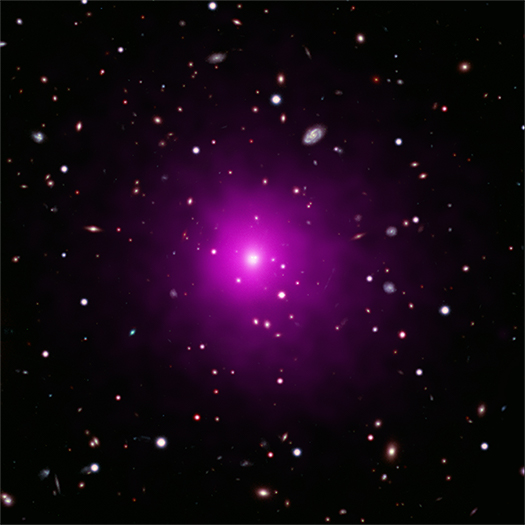
Abell 2261
Credit: X-ray: NASA/CXC/Univ of Michigan/K. Gültekin;
Optical: NASA/STScI and NAOJ/Subaru; Infrared: NSF/NOAO/KPNO
The mystery surrounding the whereabouts of a supermassive black hole has deepened.
Despite searching with NASA's Chandra X-ray Observatory and Hubble Space Telescope, astronomers have no evidence that a distant black hole estimated to weigh between 3 billion and 100 billion times the mass of the Sun is anywhere to be found.
This missing black hole should be in the enormous galaxy in the center of the galaxy cluster Abell 2261, which is located about 2.7 billion light years from Earth. This composite image of Abell 2261 contains optical data from Hubble and the Subaru Telescope showing galaxies in the cluster and in the background, and Chandra X-ray data showing hot gas (colored pink) pervading the cluster. The middle of the image shows the large elliptical galaxy in the center of the cluster.

